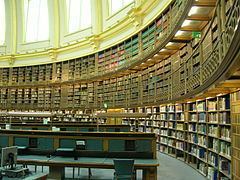Completed 1857 Opened 1857 Construction started 1854 | ||
 | ||
Similar British Museum, Queen Elizabeth II Great Court, Montagu House - Bloomsbury, British Library, Nereid Monument | ||
The British Museum Reading Room, situated in the centre of the Great Court of the British Museum, used to be the main reading room of the British Library. In 1997, this function moved to the new British Library building at St Pancras, London, but the Reading Room remains in its original form at the British Museum.
Contents
- Map of British Museum Reading Room Great Russell St Bloomsbury London WC1B UK
- Construction and design
- The British Museum Library
- Closure and restoration
- Exhibition space
- Uncertain future
- References
Map of British Museum Reading Room, Great Russell St, Bloomsbury, London WC1B, UK
Designed by Sydney Smirke and opened in 1857, the Reading Room was in continual use until its temporary closure for renovation in 1997. It was reopened in 2000, and from 2007 to 2014 it was used to stage temporary exhibitions. It has since been closed while its future use remains under discussion.
Construction and design
In the early 1850s the museum library was in need of a larger reading room and the then-Keeper of Printed Books, Antonio Panizzi, following an earlier competition idea by William Hosking, came up with the thought of a round room in the central courtyard. The building was designed by Sydney Smirke and was constructed between 1854 and 1857. The building used cast iron, concrete, glass and the latest technology in ventilation and heating. The dome, inspired by the Pantheon in Rome, has a diameter of 42.6 metres but is not technically free standing: constructed in segments on cast iron, the ceiling is suspended and made out of papier-mâché. Book stacks built around the reading room were made of iron to take the huge weight and add fire protection. There were forty kilometres of shelving in the stacks prior to the library's relocation to the new site.
The British Museum Library
The Reading Room was officially opened on 2 May 1857 with a 'breakfast' (that included champagne & ice cream) laid out on the catalogue desks. A public viewing was held between 8 and 16 May which attracted over 62,000 visitors. Tickets to it included a plan of the library.
Regular users had to apply in writing and be issued a reader's ticket by the Principal Librarian. During the period of the British Library, access was restricted to registered researchers only; however, reader's credentials were generally available to anyone who could show that they were a serious researcher. The Reading Room was used by a large number of famous figures, including notably Sun Yat-sen, Karl Marx, Oscar Wilde, Friedrich Hayek, Bram Stoker, Mahatma Gandhi, Rudyard Kipling, George Orwell, George Bernard Shaw, Mark Twain, Vladimir Lenin (using the name Jacob Richter), Virginia Woolf, Arthur Rimbaud, Mohammad Ali Jinnah, H. G. Wells and Sir Arthur Conan Doyle.
In 1973, the British Library Act 1972 detached the library department from the British Museum, but it continued to host the now separated British Library in the same Reading Room and building as the museum until 1997.
Closure and restoration
In 1997 the British Library moved to its own specially constructed building next to St Pancras Station and all the books and shelving were removed. As part of the redevelopment of the Great Court, the Reading Room was fully renovated and restored, including the papier-mâché ceiling which was repaired to its original colour scheme, having previously undergone radical redecorations (the initial design of the roof was considered excessive at the time).
The Reading Room was reopened in 2000, allowing all visitors, and not just library ticket-holders, to enter it. It held a collection of 25,000 books focusing on the cultures represented in the museum along with an information centre and the Walter and Leonore Annenberg Centre.
Exhibition space
In 2007 the books and facilities installed in 2000 were removed, and the Reading Room was relaunched as a venue for special exhibitions, beginning with one featuring China’s Terracotta Army. The general library for visitors (Paul Hamlyn Library) moved to a room accessible through nearby Room 2, but closed permanently on 13 August 2011. This is an earlier library that has also had distinguished users, including Thomas Babington Macaulay, William Thackeray, Robert Browning, Giuseppe Mazzini, Charles Darwin and Charles Dickens.
Uncertain future
In 2014, the British Museum opened its new World Conservation and Exhibitions Centre that included a specially constructed exhibition space. The museum has been consulting on the future of the Reading Room, but as of June 2014, its future is still undecided.
